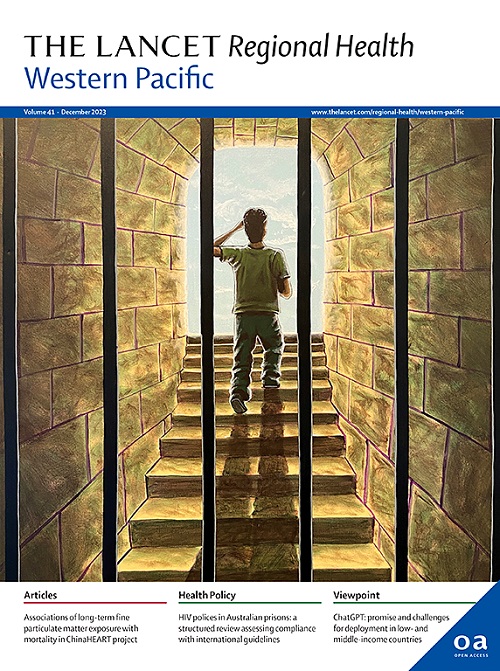Trends and inequalities in physical fitness and nutritional status among 0.72 million Chinese adults aged 20–59 years: an analysis of five successive national surveillance surveys, 2000–2020
IF 7.6
1区 医学
Q1 HEALTH CARE SCIENCES & SERVICES
引用次数: 0
Abstract
Background
Few comprehensive studies have assessed the long-term trends in physical fitness and nutritional status among Chinese adults, along with the socioeconomic inequalities. This study aimed to bridge this gap by examining the temporal changes and the evolution of socioeconomic disparities in physical fitness and nutritional status among Chinese adults aged 20–59, based on five successive national surveillance surveys.
Methods
We integrated data from five consecutive rounds of National Physical Fitness Surveillance (2000, 2005, 2010, 2014, and 2020) among Chinese adults aged 20–59 years. BMI was categorized into underweight (<18.5 kg/m2), overweight (24.0–27.9 kg/m2), and obesity (≥28.0 kg/m2). Central obesity was defined as a waist circumference ≥90 cm for males and ≥85 cm for females. A composite physical fitness indicator (PFI) was calculated by aggregating the Z-scores of all six components. Provinces were ranked by GDP per capita ($) and stratified into three socioeconomic strata from least (T1) to most developed (T3). Generalized additive models (GAMs), adjusted for age and sex, were employed to assess the associations between nutritional status, PFI, and both per capita GDP and urbanization levels.
Findings
A total of 716,790 Chinese adults aged 20–59 were included in the analysis. The PFI score declined from 0.71 in 2000 to −0.84 in 2020, with a particularly sharp annual decline between 2014 and 2020. The underweight prevalence declined from 5.54% in 2000 to 3.51% in 2020, while the prevalence of overweight, obesity, and central obesity increased to 35.84%, 15.05%, and 32.10% in 2020, respectively. After 2005, the urban-rural disparities in physical fitness narrowed, whereas the gap between most and least developed regions widened, with urban and high-SES regions consistently showing better fitness. The prevalence of overweight, obesity, and central obesity in urban and economically developed regions was higher than in less economically developed and rural regions in earlier years, but this pattern reversed over time. The underweight prevalence showed the opposite trend. With increasing GDP per capita, PFI initially rose before declining at higher levels, and it showed a positive correlation with urbanization. Overweight prevalence increased with GDP per capita but slowed at higher levels, while obesity and central obesity exhibited an N-shaped relationship with GDP per capita. Moreover, prevalence of overweight, obesity, and central obesity were positively correlated with urbanization.
Interpretation
During the first two decades of the 21st century, China experienced rapid economic growth accompanied by declining physical fitness and rising prevalence of overweight, obesity, and central obesity among adults aged 20–59 years. Inequalities in nutritional status between urban and rural areas and across socioeconomic strata reversed. Less developed and rural regions may face dual challenges of deteriorating physical fitness and the growing burden of overnutrition, which requires urgent attention. The complex interplay between socioeconomic development, urbanization, and physical health further emphasizes the need for health policies tailored to diverse socioeconomic contexts and subpopulations.
Funding
National Natural Science Foundation of China (72474005, 72122001) and the Peking University Health Science Center-Weifang Joint Research Center for Maternal and Child Health (PKUWF-Y12).
背景很少有综合性研究对中国成年人体质和营养状况的长期趋势以及社会经济不平等现象进行评估。本研究旨在通过连续五次全国国民体质监测,研究中国 20-59 岁成年人体质和营养状况的时间变化和社会经济差异的演变,从而弥补这一空白。方法我们整合了连续五轮国民体质监测(2000 年、2005 年、2010 年、2014 年和 2020 年)中 20-59 岁中国成年人的数据。体重指数分为体重不足(18.5 kg/m2)、超重(24.0-27.9 kg/m2)和肥胖(≥28.0 kg/m2)。中心性肥胖的定义是男性腰围≥90厘米,女性腰围≥85厘米。综合体质指标(PFI)是将所有六个组成部分的 Z 值汇总计算得出的。各省按人均国内生产总值(美元)排名,并分为三个社会经济阶层,从最不发达(T1)到最发达(T3)。在对年龄和性别进行调整后,采用广义相加模型(GAMs)来评估营养状况、PFI 与人均 GDP 和城市化水平之间的关联。PFI 分数从 2000 年的 0.71 降至 2020 年的-0.84,其中 2014 年至 2020 年的年降幅尤为明显。体重不足患病率从 2000 年的 5.54% 下降到 2020 年的 3.51%,而超重、肥胖和中心性肥胖患病率则分别上升到 2020 年的 35.84%、15.05% 和 32.10%。2005 年后,城乡体质差距缩小,而最发达地区和最不发达地区之间的差距扩大,城市和高社会经济地位地区的体质一直较好。早些年,城市和经济发达地区的超重、肥胖和中心性肥胖发生率高于经济欠发达地区和农村地区,但随着时间的推移,这种模式发生了逆转。体重不足的发生率则呈现出相反的趋势。随着人均 GDP 的增加,PFI 开始上升,然后在较高水平上下降,并且与城市化呈正相关。超重率随着人均 GDP 的增加而增加,但在较高水平上有所减缓,而肥胖和中心性肥胖与人均 GDP 呈 N 型关系。此外,超重、肥胖和中心性肥胖的发生率与城市化呈正相关。解读在 21 世纪的前 20 年,中国经历了快速的经济增长,同时伴随着体质下降以及 20-59 岁成年人超重、肥胖和中心性肥胖发生率的上升。城乡之间和不同社会经济阶层之间营养状况的不平等出现了逆转。欠发达地区和农村地区可能面临体质下降和营养过剩负担日益加重的双重挑战,亟需引起重视。社会经济发展、城市化和体质健康之间复杂的相互作用进一步强调了针对不同社会经济背景和亚人群制定健康政策的必要性。
本文章由计算机程序翻译,如有差异,请以英文原文为准。
求助全文
约1分钟内获得全文
求助全文
来源期刊

The Lancet Regional Health: Western Pacific
Medicine-Pediatrics, Perinatology and Child Health
CiteScore
8.80
自引率
2.80%
发文量
305
审稿时长
11 weeks
期刊介绍:
The Lancet Regional Health – Western Pacific, a gold open access journal, is an integral part of The Lancet's global initiative advocating for healthcare quality and access worldwide. It aims to advance clinical practice and health policy in the Western Pacific region, contributing to enhanced health outcomes. The journal publishes high-quality original research shedding light on clinical practice and health policy in the region. It also includes reviews, commentaries, and opinion pieces covering diverse regional health topics, such as infectious diseases, non-communicable diseases, child and adolescent health, maternal and reproductive health, aging health, mental health, the health workforce and systems, and health policy.
 求助内容:
求助内容: 应助结果提醒方式:
应助结果提醒方式:


